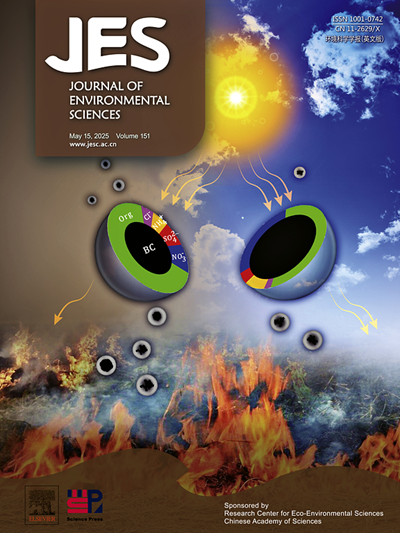Hierarchical V2O3 spiny hollow nanosphere for efficient adsorption of precious metal ions in complicated matrices
IF 5.9
2区 环境科学与生态学
Q1 ENVIRONMENTAL SCIENCES
引用次数: 0
Abstract
Treatment of precious metals in electronic waste has attracted tremendous attention and is essential for both environmental protection and resource sustainable development. In this study, a novel adsorbent for precious metal ions, V2O3 spiny hollow nanospheres (p-V2O3 SHN), was synthesized through a one-step hydrothermal-assisted methodology for the adsorption of Au(III), Ag(I), Pd(II), and Pt(IV) from the leaching solution of electronic waste. The results reveal that the p-V2O3 SHN hierarchy was successfully constructed with a hollow structure and dense spiny morphology. The prepared p-V2O3 SHN can effectively remove precious metal ions such as Au(III), Ag(I), Pd(II), and Pt(IV), with the selective capture order being Au(III) > Ag(I) > Pt(IV) > Pd(II) > other metal ions. This superior adsorption capability can be attributed to the multi-diffusible, intermingled composition, and numerous active sites decorating the p-V2O3 SHN hierarchy, facilitating the uptake of Au(III), Ag(I), Pd(II), and Pt(IV) ions from electronic waste. The Langmuir model provided a better fit for the uptake process, revealing maximum uptake capacities of 833.33 mg/g for Au(III), 370.37 mg/g for Ag(I), 42.01 mg/g for Pd(II), and 77.51 mg/g for Pt(IV) on p-V2O3 SHN. Remarkably, p-V2O3 SHN exhibited a robust affinity for the adsorbate due to the presence of surface defects and reduction reactions. The new p-V2O3 SHN also demonstrated good reusability for three sorption cycles, highlighting its potential for electronic waste treatment. Due to its facile synthesis and excellent efficiency, hierarchical p-V2O3 SHN presents itself as a promising candidate for the selective uptake of Au(III), Ag(I), Pt(IV), and Pd(II) from electronic waste.

求助全文
约1分钟内获得全文
求助全文
来源期刊

Journal of Environmental Sciences-china
环境科学-环境科学
CiteScore
13.70
自引率
0.00%
发文量
6354
审稿时长
2.6 months
期刊介绍:
The Journal of Environmental Sciences is an international journal started in 1989. The journal is devoted to publish original, peer-reviewed research papers on main aspects of environmental sciences, such as environmental chemistry, environmental biology, ecology, geosciences and environmental physics. Appropriate subjects include basic and applied research on atmospheric, terrestrial and aquatic environments, pollution control and abatement technology, conservation of natural resources, environmental health and toxicology. Announcements of international environmental science meetings and other recent information are also included.
 求助内容:
求助内容: 应助结果提醒方式:
应助结果提醒方式:


